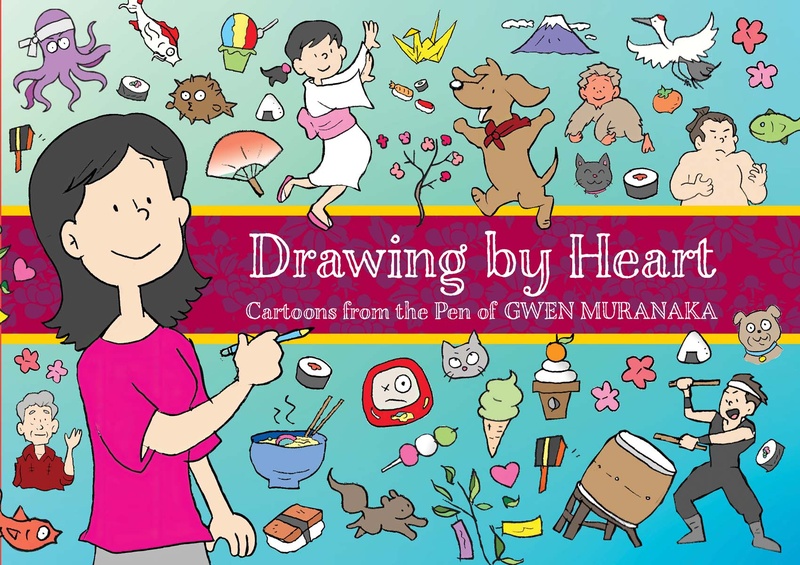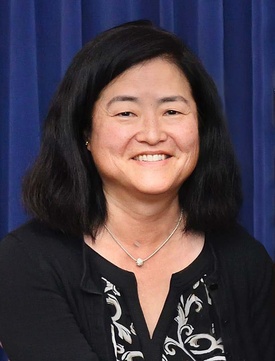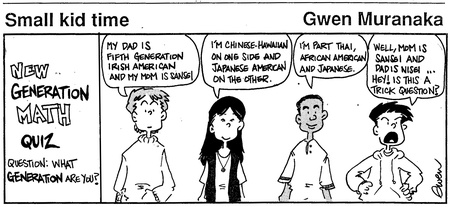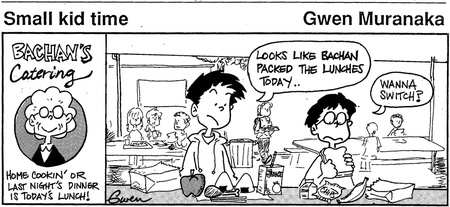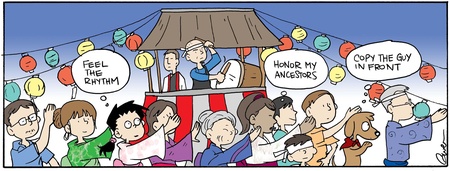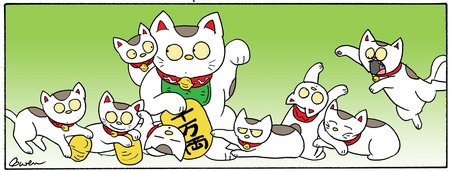Gwen Muranaka is one of those rare individuals who is doing exactly the job they dreamed of as a kid. “I think as a kid I either wanted to be a cartoonist or a reporter,” she said, “and I’ve kind of been able to do both. So I’m really grateful to do the two things I’ve always had a love for!”
Muranaka is senior editor of Little Tokyo’s The Rafu Shimpo daily newspaper and a cartoonist for The Hawaii Herald and Rafu Shimpo. She recently published a book of her cartoons, aptly titled Drawing by Heart—a heart-felt example of colorful visual storytelling that draws on her own life experiences and presents themes of identity, culture, and cross-cultural living that will resonate with readers of all ages. From cartoons depicting a packed commute on a Tokyo train to a visual homage to “SPAM Super Bowl” snacks, Muranaka’s cartoons depict all things Japanese and Japanese American with a healthy dose of cuteness mixed in.
The book, a compilation of cartoons drawn across years and even continents, has been a long time coming for Muranaka. “I’ve been wanting to do a book of cartoons for years and years and I have so many of them,” she said, noting that it felt daunting to know how to organize cartoons that she drew for various publications both in the U.S. and in Japan. In the end, she realized the organization of the book ended up mirroring her own life trajectory:
“I didn’t intend to, but the cartoons sort of trace my own personal journey going from working at the Pacific Citizen, moving to Tokyo working at Japan Times, and then coming back working at The Rafu Shimpo in Little Tokyo. It’s kind of in its own way autobiographical in that sense, but not super duper like a serious autobiography or something, but just some of the issues I dealt with, the things I saw living in Japan as a Japanese American, and then having to do a cartoon once a week for The Japan Times forced me to do a lot of them for quite a while.”
More recently, Muranaka’s cartoons have been inspired by her father and his three adopted cats, whose adventures together form the basis of the cartoon “Dad’s Three Cats,” published in The Hawaii Herald and Rafu Shimpo.
Though many of her cartoons in the past focused on the experience of being a Japanese American living in Japan, she has found that now she is drawing cartoons that are, as she puts it, “more about a Japanese American identity.” With “Dad’s Three Cats” she said, “I’m kind of looking at—I’m not even sure if you’d call it aging—but maybe celebrating some of our elderly in a way through my dad.” Muranaka wondered if she wouldn’t be doing as many cartoons now if it weren’t for her dad and his cats. “It’s been kind of fun to do those [cartoons],” she said, “and reconnect with him and with cartooning.”
Even as her cartoons tell Muranaka’s personal story of being Japanese American, they are also eminently relatable to anyone who has ever lived abroad, had the experience of being a “foreigner,” or navigated a bi- or multi-cultural identity. “I guess I always thought it was for people like me who’ve maybe had these experiences, and it doesn’t necessarily mean they have to be Japanese American, but it probably helps,” she said, noting that really the book is for “anyone who has kind of struggled with feeling in a different culture or finding these issues that come up.”
Though Muranaka’s cartoons often deal with heavy and complicated subjects—aging, navigating cross-cultural living, identity, and history—she feels that cartooning can bring a unique and oft-needed lightness to these situations. In a way, she hopes the cartoons can provide a “fun entryway” into discussions about Japanese American identity, culture, and traditions.
“I guess talking to maybe more Sansei generation, they really feel like [they] want to pass on a lot of these things to the younger generation, and I feel like this is a good way to do it,” she explained. “I guess many of us have had experiences going to Japan and feeling like you don’t quite fit in, having these things happen, and so maybe it’s a way of kind of laughing about some of these things that we’ve all experienced.”
Beyond providing a way to laugh about shared experiences, Muranaka also hopes that her book of cartoons will generate conversations for a multigenerational audience. Though her book has not circulated widely yet, she has found that it has already been well-received by perhaps the harshest of book critics—children. This response encourages Muranaka: “I’m hoping that it kind of helps kids see their own culture in some way…that they find ways where they can identify with JA stuff without being real serious.”
Muranaka also notes that the book may inspire children—or adults—to share their own stories: “Everyone has these things that we deal with, and I just hope it kind of sparks something, that people say, ‘Hey, I need to put something down,’ if it’s cartooning or writing or whatever…I hope it sparks some of that.”
Muranaka’s own journey as a cartoonist started when she was a kid. “I’ve always been a cartoonist, I don’t know. I was always one of those kids who liked to draw…and I just kept doing it and doing it, and I went to the newspaper and said, ‘hey I wanna try drawing a cartoon! My first efforts weren’t great or amazing or anything but I just kind of kept at it, and I had editors who were willing to let me keep working on my skills.” Her advice for aspiring cartoonists, writers, and storytellers? “I think you just keep at it, and you’ll find your voice. You just keep at it, be persistent, and tell your story. The more you do it the better you get, I think.”
While Muranaka’s work as a cartoonist has paralleled her career as a journalist and editor, she finds it helpful to separate the two roles. “Because I’m a writer at a newspaper, for the most part everything I do is very serious,” she explained. Rather than take a similarly serious, perhaps more editorial cartoonist approach, she sees her cartooning as a way to bring some much-needed fun: “I think we also need times of levity, times of just having fun, and I think a cartoon is good for that.”
When asked what she felt cartoons could express that her writing could not, Muranaka explained that cartooning is sometimes able to communicate visually what it may take a profusion of words to convey: “I mean I think cartooning is such a direct thing, that it can go both ways—you can do things that are very emotional and joyful and you can capture so many different things in a cartoon.”
Now, she says, a little levity seems to be exactly what’s in order for her community. “These days I think, we’ve had such a tough go of it as a community in the last few years, I look at my cartoons as a way to just kind of bring a smile—just as simple as that, to bring a little joy, because you know as a reporter we’ve done all this anti-Asian hate and a lot of heavy, dark topics, so I think the cartoon is sort of a relief from some of that.”
To both kids and those who are kids-at-heart, Muranaka’s fun and genuine book of cartoons is sure to bring just this sense of joy—and, undoubtedly, some great conversations over SPAM musubi snacks, as well.
* * * * *
JANM Book Club: Drawing by Heart with Gwen Muranaka
Japanese American National Museum
Saturday, November 18 from 2 - 3:30 p.m.
Join Gwen Muranaka for a talk on cartoons, creativity, and the inspirations in her life. She will be in a conversation with Susan Hirasuna, anchor of Fox 11 News, about her new book, Drawing By Heart, which is a compilation of cartoons and cross-cultural commentary. A whimsical excursion into a world of outspoken cats and dogs, where cultures clash and Spam musubi is a staple, Muranaka’s book sheds light on the unique, funny things that make us Japanese American.
*Drawing by Heart is available for purchase at the JANM Store.
© 2023 Amelia Ino


